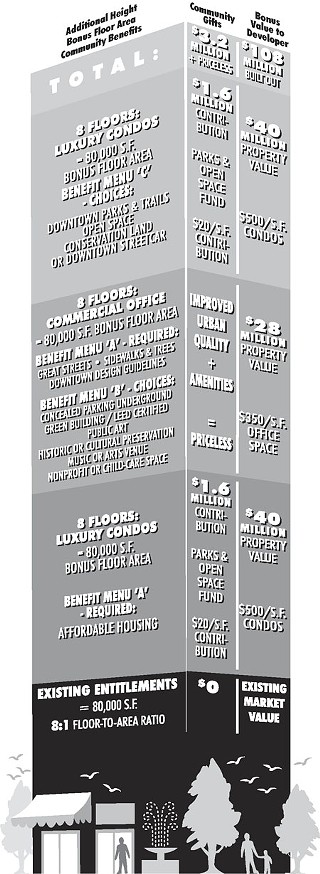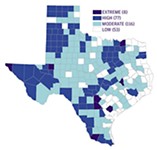Density Bonuses
Three concepts
By Katherine Gregor, Fri., Oct. 26, 2007
Project Assumptions
Quarter block site = 138-feet-by-138-feet = 19,044 square feet
Building footprint = 10,000 square feet
Existing entitlements = 80,000 square feet (eight floors)
Maximum height desired = 32 floors
DISCLAIMER: These illustrations ignore a multitude of real-world development realities. They are provided only as visual representations to help communicate concepts. Do not take them to your banker.
Model No. 1: Combo Menu

Here's an example of how a "menu" system could work: developers earn additional square footage for their buildings by providing certain predefined community benefits, either through features of the project or by paying fees.
Here's one example of a "menu" approach to community benefits, which has been recommended by the Density Bonus Task Force of the Design Commission.
Each benefit provided by a developer would earn a specified number of points, which could then be traded for density bonuses. Some project features deemed "point-worthy" – such as energy efficiency, or wide sidewalks with trees – represent an initial cost to the developer and a value to the community; in other cases, the developer could earn points by paying a fee. (In this example, we assume a fee of $20 per square foot; see story.)
For all projects, the first benefit menu tier would be "baseline requirements," with affordable housing as the most basic requirement – either on-site or via a fee-in-lieu. Individual districts Downtown, and potentially citywide, would get custom menus reflecting their priorities and needs.
Once the baseline requirements are met, the developer could build still higher in exchange for more community benefits. The specific benefits shown here are from the Design Commission's suggested list. (But the "bonus" heights and fees amounts are our hypothetical examples, used for illustrative purposes only.) In reality, one building would be unlikely to use every category of community benefit. A developer potentially could elect 100% affordable-housing contributions – in this model, triple the $1.6 million shown.
Model No. 2: 100% Affordable Housing

In this model, suggested by the Affordable Housing Incentives Task Force recommendations, among others, all residential projects would have to make 10% of their bonus-award units "affordable" or pay a fee-in-lieu to the city's Affordable Housing Trust Fund.
In this example, developers would earn density bonuses solely by affordable-housing contributions. This single-goal approach is reflected in the Affordable Housing Incentives Task Force recommendations for Downtown and, as a citywide supplement, in the density-bonus policy advocated by the city's Community Development Commission. In both sets of recommendations, all residential projects would have to make 10% of their bonus-award units "affordable," thus providing (at a loss) attainable housing on-site. In the AHITF system, residential developers could choose instead to pay a fee-in-lieu to the city's Affordable Housing Trust Fund at a rate of $10 per bonus square foot. Potentially, all commercial/office space would be subject to this same fee-in-lieu.
For condo towers, the AHITF recommends that 10% of bonus units be affordable for households at or below 120% median family income. (According to the Department of Housing and Urban Development, for 2007 Austin's family MFI is $69,300.) For apartments, 10% of bonus units would be affordable for households at or below 80% MFI – that's $45,500 for a couple. (The CDC recommends deeper affordability.) Unfortunately, that yields a paltry number of homes for average-income citizens – in the example shown, just 16 units. Due to construction costs, developers aren't building high-rise apartments now; condo units set aside as "affordable" likely would be tiny studios, rather than family-sized homes.
A fee-in-lieu approach could yield many more affordable homes – if they don't have to be built in dirt-pricey Downtown. In this model, the 16 floors of condos could yield $1,600,000 for the affordable-housing trust fund (instead of 16 units) if a fee of $10 per square foot were paid. That amount could help underwrite construction of 200 affordable low-rise units, at an $80,000 subsidy each, within two miles of Downtown. Double the fee to $20/square foot (as used in Model No. 1) and the community gets $3.2 million for central affordable housing. However, some advocates believe it's a top priority, on principle, for Downtown to house people from all walks of life, even though that means losing more low-income homes elsewhere.
Model No. 3: Increase Base Entitlements

Not surprisingly, the Downtown Austin Alliance prefers a simpler plan: The city should just raise the size limits on Downtown property. For a quarter-block tract, the DAA proposes quadrupling the base limit, to allow 32 stories as the baseline.
Downtown property owners, as represented by the Downtown Austin Alliance, think they're doing plenty for the community simply by building high-rises. They prefer the historical system: no requirement that extra community benefits be funded by the developer. Calling current limits of 8-1 floor-to-area ratio an "antiquated concept," the DAA position – its board response to the Design Commission recommendations – suggests that council should immediately increase entitlements for Downtown property owners as an interim step. Such a handout would dramatically increase the market value of Central Business District properties – yielding a huge profit windfall for the lucky landowner few.
The DAA correctly argues that increasing Downtown density is itself an identified community goal, and that "any new policy should encourage – not create a penalty for – increased density" Downtown. The DAA is also quick to remind us that each new high-rise yields millions more annually in property taxes, for city coffers. If Austin wants specific community benefits, says the DAA, then it should set aside a percentage of those new property taxes to fund them.
The DAA proposes increasing entitlements Downtown by site size. For half-blocks, they advocate immediately doubling entitlements, from 8-1 FAR to 16-1 FAR. For quarter blocks (example shown) they would quadruple entitlements, to 32-1 FAR. In return, owners/developers will promise to ... build whatever the hell they want on their own land.
This is Texas, after all.
Got something to say on the subject? Send a letter to the editor.








